The temptation Gospel is always read on the first Sunday of Lent, for as Christ went into the desert for forty days, so we follow his example and enter the penitential season for forty days. Traditionally, the desert is a place for trial but also for prayer and transformation. In fasting for forty days in the desert, Christ follows and fulfills the examples of Adam, Elijah, Moses, and Israel, and also provides an example for us.
As Augustine says, (De Trin. iv) “Christ allowed Himself to be tempted" by the devil, "that He might be our Mediator in overcoming temptations, not only by helping us, but also by giving us an example."
The images of the temptation from illuminated manuscripts imagistically connect Christ to these Old Testament figures while also anticipating his saving action on the Cross. They highlight the way Christ weaves together threads and images from the Old Testament, bringing them to their heavenly fulfillment.
Today we will explore the artistic themes present in depictions of Christ’s Temptation from various illuminated manuscripts.
In the Gospels, Christ’s temptation immediately follows his Baptism and anointing, and so we find these images paired commonly. Together, these images provide a meditation on the way Baptism and the sacraments are a preparation for the combat of the spiritual life in which we can expect to face temptation as we battle our vices. In a homily, St. John Crysostom tells us that Christ, through his time in the wilderness, gives us an example for how to arm ourselves for spiritual warfare.
For since Jesus did and underwent everything with a view to our instruction he likewise consented to be led there and wrestle against the devil in order that every baptized person who, after baptism, has to endure greater temptations may not be troubled as though this outcome were unexpected, but may continue to endure everything nobly as though it were happening in the natural course of things. For indeed, this was the reason you took up arms, not to be idle, but to fight.
It can be interesting to compare the appearance of Christ and the devil. In most images of this theme, Christ holds up his right hand, and holds scripture tightly in his left. While Christ appears serene and composed, clothed in splendid garments, the devil, shrouded in darkness, appears grotesque and beastly, and even comical at times. In later manuscripts, artists highlight the seductive nature of the devil, showing how he can hide himself in fine robes, or even the robes of monks and cardinals.
While some images of the temptation show all three temptations, they are often collapsed into one image, commonly an image of the first temptation:
At that time, Jesus was led by the Spirit into the desert, to be tempted by the devil. And when he had fasted forty days and forty nights, afterwards he was hungry. And the tempter coming, said to him: If thou be the Son of God, command that these stones be made bread. He answered and said: It is written: Not in bread alone doth man live, but in every word that proceedeth from the mouth of God. (Matthew 4:1-4)1
Images which highlight the first temptation, a temptation of the flesh, often include a mysterious tree, which sprouts between Christ and the devil. The tree is a clear allusion to Adam’s temptation. As the Catechism says, Christ’s temptations “recapitulate the temptations of Adam in Paradise and of Israel in the desert.”
Whereas Adam failed to fast from the tree of good and evil, Christ keeps the fast and anticipates his final victory. Some images even explicitly connect these images such as the Bible Moralisee below.
Thus, Christ is the new Adam, tempted in every way and yet undefiled. As St. Paul reminds us, “He might be one tempted in all things such as we are, without sin, and so become for us a High Priest who knew how to have compassion on our infirmities.”(Heb. 4:15)
Through his death and resurrection, Christ transforms the tree of temptation into a tree of life and victory. The golden background of these miniatures as well as the presence of trees and a mountain, point also to paradise, which Christ has re-opened for us by his Sacrifice.
Images of the second temptation usually appear in sequence with the others, except for the illumination in the Book of Kells. Matthew describes this temptation:
Then the devil took him up into the holy city, and set him upon the pinnacle of the temple, and said to him: If thou be the Son of God, cast thyself down; for it is written: He hath given his angels charge over thee, and in their hands shall they bear thee up, lest perhaps thou dash thy foot against a stone. Jesus said to him: It is written again: Thou shall not tempt the Lord thy God. (Matthew 4:5-7)
Here Christ responds to the devil’s temptation to pride with humility and words from the commandments, showing that he submits to the law. However, these images of Christ atop the temple also remind us that Christ is the head of the Church, the fulfillment of the temple. The mysterious image in the Book of Kells also includes the angels who minister to Christ. The temple here seems to double as the mountain from the last temptation, as the artist has included a crowd of people.
Again the devil took him up into a very high mountain, and showed him all the kingdoms of the world, and the glory of them; and said to him: All these will I give thee, if, falling down, thou wilt adore me. Then Jesus said to him: Begone, Satan, for it is written, The Lord thy God shall thou adore, and him only shall thou serve. Then the devil left him; and behold, angels came, and ministered to him. (Matthew 4:8-11)
Matthew records that Christ’s journey into the wilderness ends on the mountain. It is significant that his temptations end here, for Biblically the mountain is of enormous importance. The image connects Christ’s trials to Moses and Elijah, who encountered trials in the wilderness but were met with consolation on the mountain. Moses saw God on Mount Sinai where he received the tablets of the law and later saw the promised land from a mountain. Elijah too met Christ in the still small voice on Mount Horeb.
Biblically, the mountain is the meeting place for God and man, the place where God consoles and reveals himself to his people. At the end of his journey Christ meets the most intense temptation, that of worldly power and pride of life. Christ refuses the devil’s false promises by quoting from the tablets of the law which Moses received on Sinai.
Perhaps most importantly, these images highlight the way Christ, the Word himself, arms himself with scripture throughout his temptation. In the image above, Christ and the devil appear to be dueling with scripture. But while the devil twists scripture out of its context, Christ is sensitive to the meaning of the words he chooses to use against the devil. Thus, Christ is often shown holding the Bible, for he takes the whole of scripture, not single verses out of context. In clinging to scripture, Christ gives us an example for how to humbly shield ourselves with scripture. As Fr. Jacques Phillipe writes,
It (Scripture) is not a magic wand that renders us immune to all complexity and anguish. But in trusting adherence to God's Word, we find a mysterious strength that nothing else can provide. It has a special power to establish us in hope and peace, no matter what happens. Referring to God's promise to Abraham, the Epistle to the Hebrews explains that "in all disputes an oath is final for confirmation" (Heb 6:16). The Word of God, received in faith, has the power to put an end to our indecision and the vacillation of our reasoning, and establish us firmly in truth and peace. The hope brought by this Word is "a sure and steadfast anchor of the soul" (Heb 6:19). Scripture contains countless passages that can be a valuable support for us in our struggles.
If we feel alone and abandoned, Scripture tells us, "Can a woman forget her sucking child, that she should have no compassion on the son of her womb? Even these may forget, yet I will not forget you" (Is 49:15). If we feel that God is far away, Scripture says, "I am with you always, to the close of the age" (Mt 28:20). If we feel crushed by our sins, it responds, "I will not remember your sins" (Is 43:25). If we feel that we lack the resources we need to advance in life, one of the psalms invites us to make this act of faith: "The Lord is my shepherd, I shall not want" (Ps 23[22]:1).2
The Gospel reading from Matthew prepares us for the trials we may face during this season of penance and fasting, and warns us of the trials and attacks we too may face during Lent, which may worsen towards the end, when we may begin to feel discouraged about our paltry penances. Even our trials and temptations can, as Saint John Crysostem says, help us to “remain humble and not be puffed up by the greatness of your gifts.” Still, the reading does not leave us without consolation, as it points us to the angels as well as to Christ’s victory.
Immediately after the devil departs, angels come to minister to Jesus, giving him consolation to end his fast, as in the below image. He humbly welcomes their aid. Similarly for us, after Lenten penance, we will celebrate his victory on Easter, and after our wilderness pilgrimage in this world, we hope to live happily with him forever in the next.
I am using the Gospel of Matthew because it is the most complete account and the account which the illuminated manuscripts most commonly follow.
I am using this quote from
’s recent article on scripture, which I highly recommend.




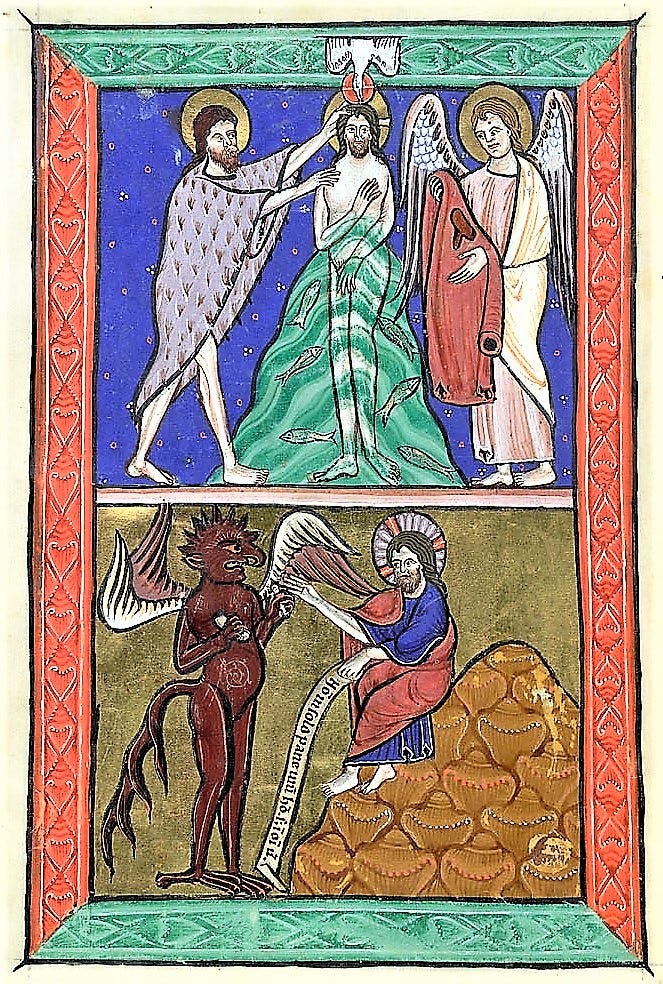
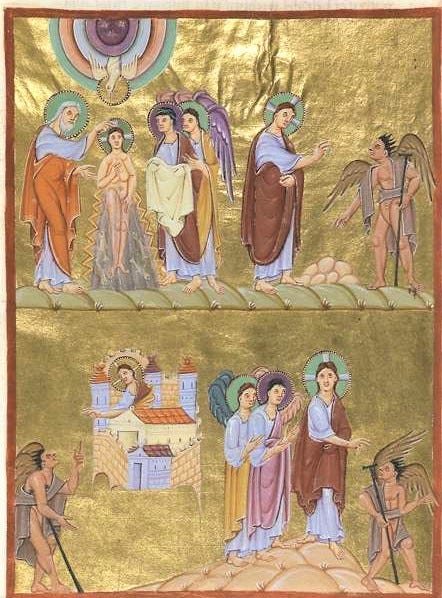
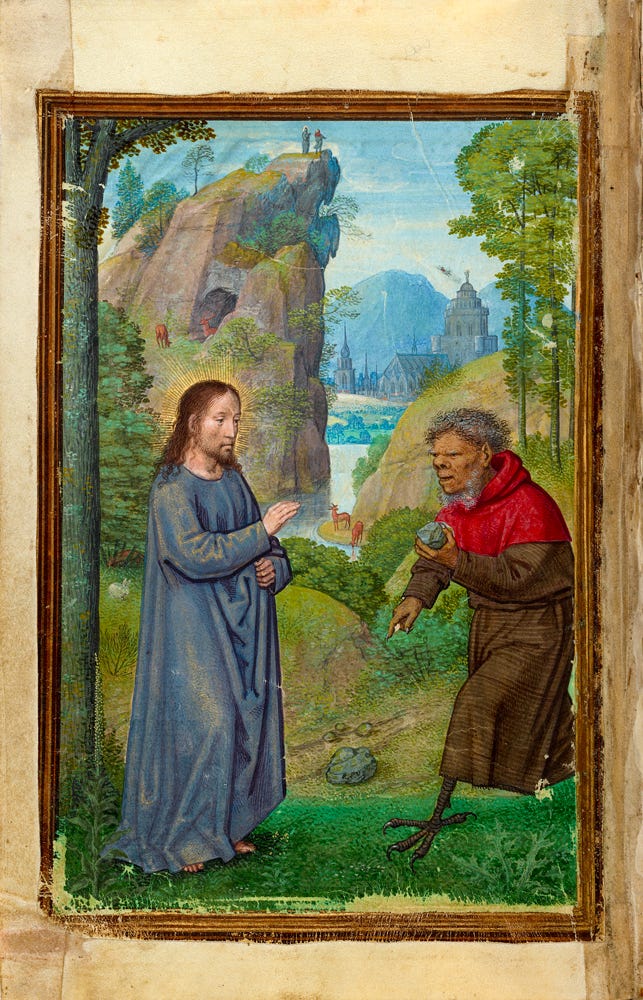

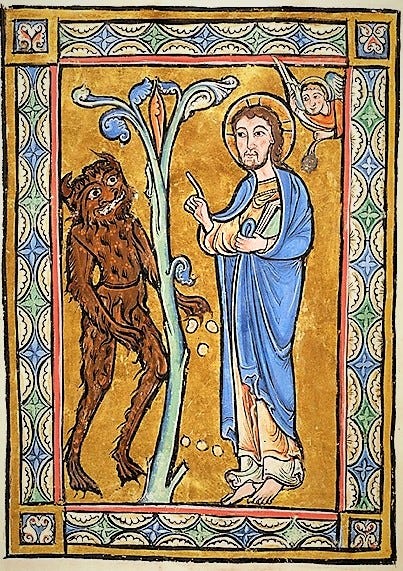

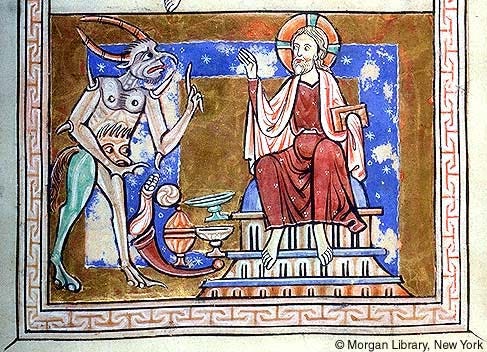
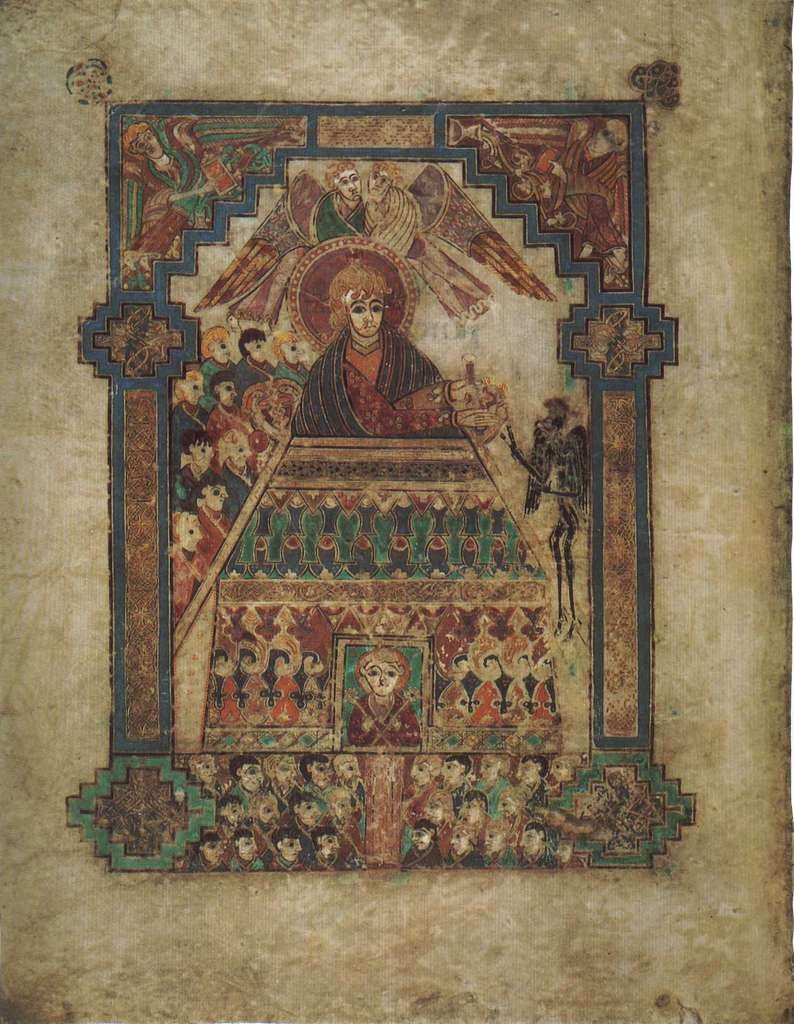
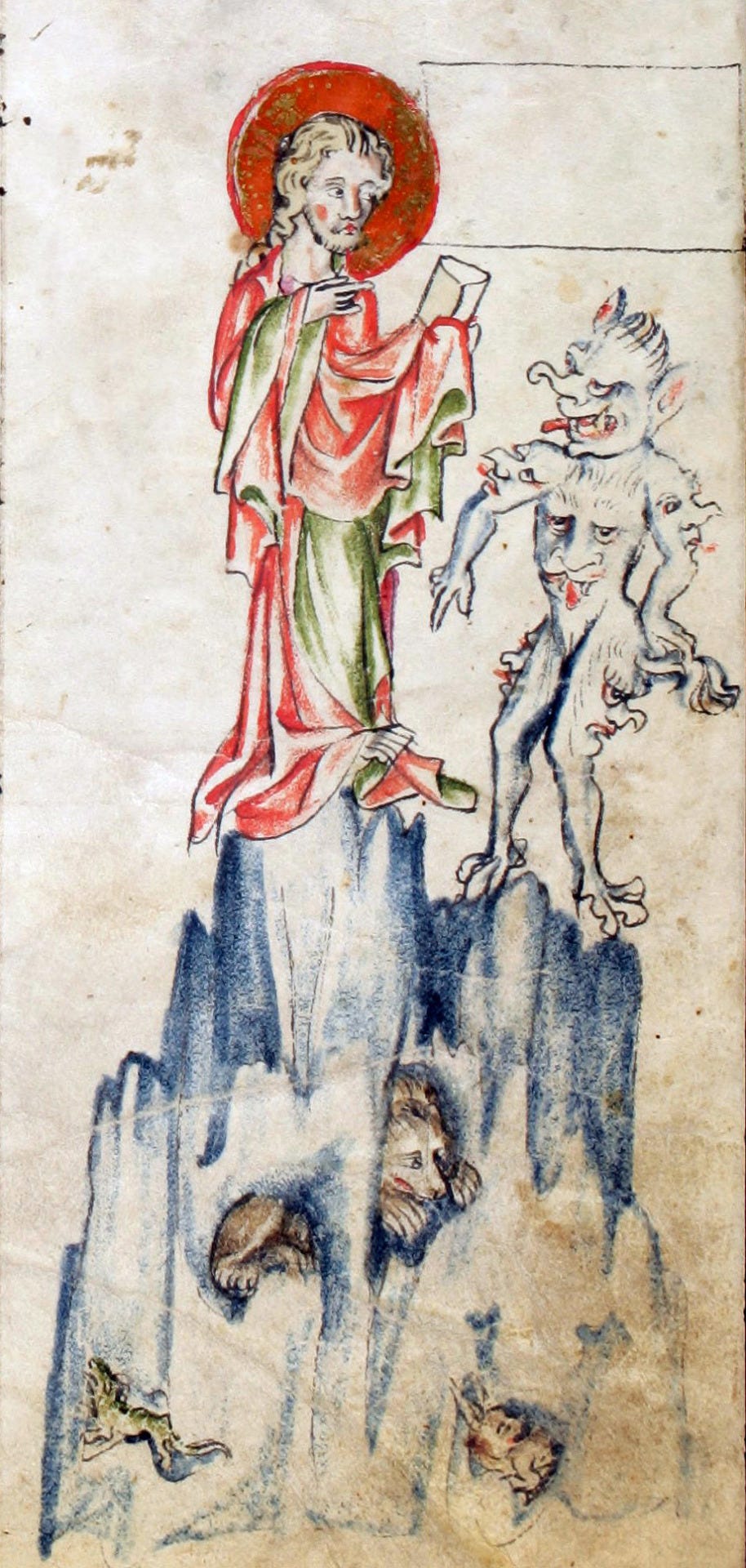

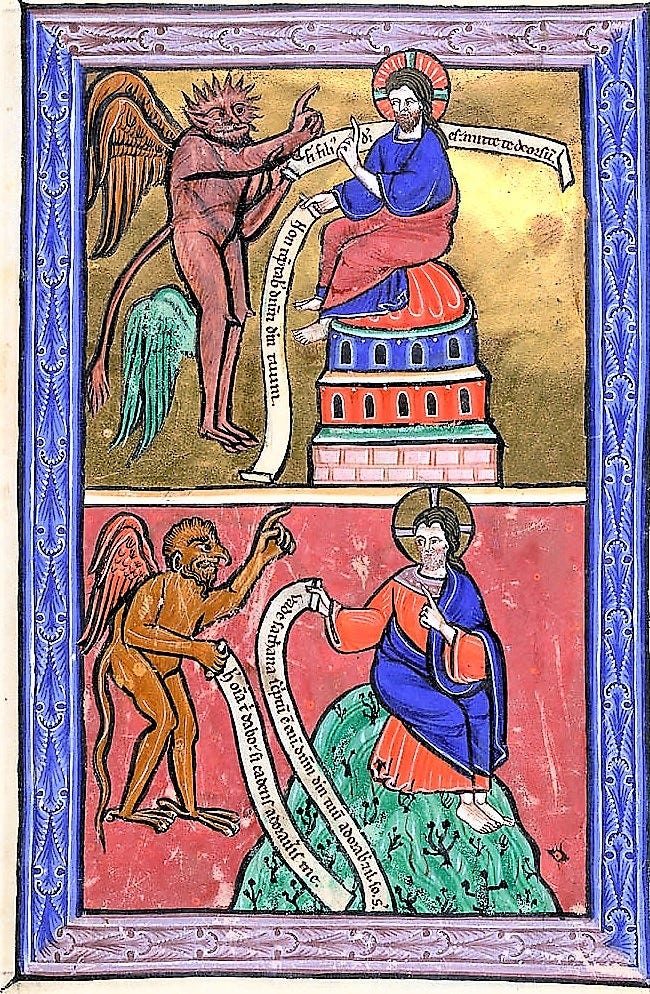
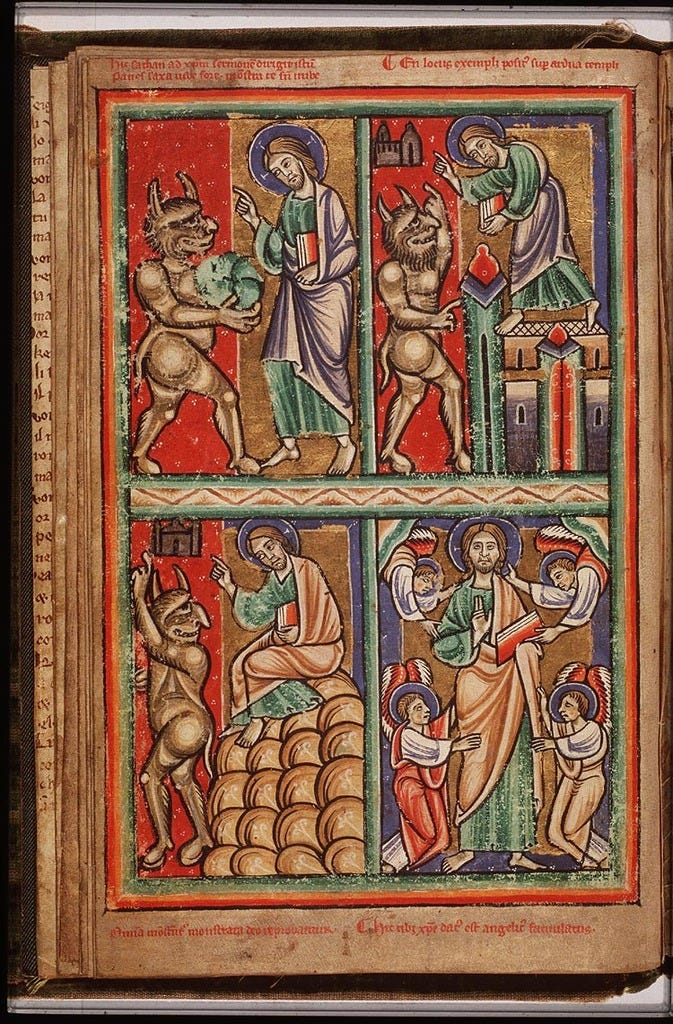

All of these wonderful images are excellent iconographic interpretations of the deep meanings of such biblical episodes. Thank you for this impressive work!
These images are wonderful! Thank you.